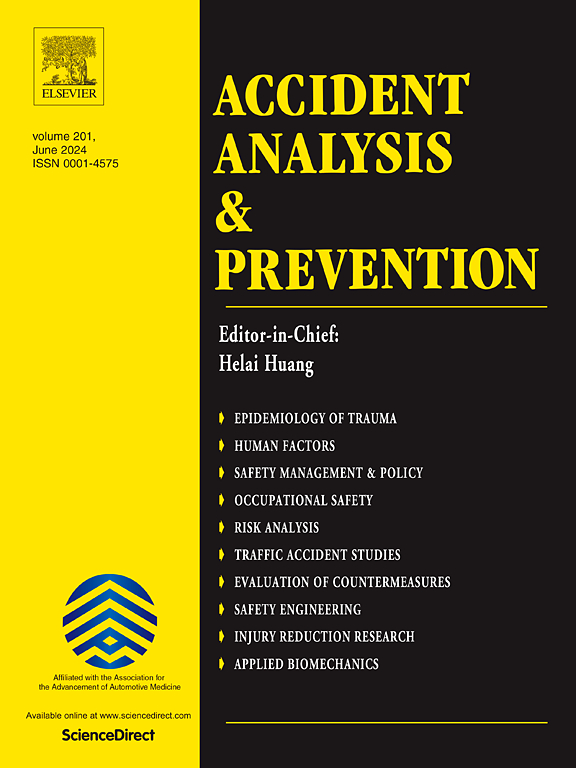Driving fingerprinting enhances drowsy driving detection: Tailoring to individual driver characteristics
IF 5.7
1区 工程技术
Q1 ERGONOMICS
引用次数: 0
Abstract
Background
Drowsiness detection is a long-standing concern in preventing drowsiness-related accidents. Inter-individual differences seriously affect drowsiness detection accuracy. However, most existing studies neglected inter-individual differences in measurements’ calculation parameters and drowsiness thresholds. Studies without considering inter-individual differences generally used selfsame measurements and drowsiness thresholds for each participant rather than individual optimal measurements and personalized thresholds, which reduces the contribution of measurements and drowsiness detection accuracy at the individual level. Additionally, Driving Fingerprinting (DF) that represents individual traits has not been well applied in drowsiness detection.
Methods
We built the Individualized Drowsy driving Detection Model (IDDM) utilizing DF, extracting individual driver’s optimal drowsiness characteristics to detect drowsiness. Firstly, we conducted simulated driving experiments with 24 participants (2:1 male-to-female ratio, diverse ages and occupations including professional taxi drivers and graduate students) and collected data on their driving behavior, facial expressions, and the Karolinska Sleepiness Scale (KSS). Secondly, we employed a Two-layer Sliding Time Window (TSTW) to calculate DF measurements. Thirdly, we utilized attribution directed graphs to visualize DF, understand changes in DF with drowsiness, and analyze accident risks. Finally, we used DF matrices to build the IDDM. The IDDM utilized an improved adaptive genetic algorithm to extract the optimal drowsiness characteristics of individual drivers. These DF matrices, constituted by the optimal drowsiness characteristics of individual drivers, were used to train the IDDM based on principal component analysis and radial basis function neural networks. The TSTW strengthened the variation of DF with drowsiness, and the trained IDDM excavated the relationships between DF characteristics and drowsiness, which improved the accuracy and end-to-end timeliness of practical applications. The DF visualization displayed DF variations with drowsiness, theoretically supporting the use of DF to enhance personalized drowsiness driving detection.
Results
The DF visualization indicated drowsiness caused the distribution and transition probabilities of DF measurements to shift toward unsafe directions, thereby increasing the accident risk and demonstrating the rationality for utilizing DF to recognize drowsiness. The proposed IDDM achieved average accuracy, sensitivity, and specificity of 95.58 %, 96.50 %, and 94.70 %, respectively, outperforming most existing models. The trained IDDM demonstrated an average execution time of 0.0078 s and lower computational costs due to the reduction of PCA and simple RBFNN compared with models based on deep learning, and no requiring physiological data, which reduced invasiveness and enhanced feasibility for real-world implementation. The IDDM still committed challenges like integration with existing systems and concerns about privacy, which should be adjusted in implementations. This study supports the anti-drowsiness warning systems for preventing drowsiness-related accidents and promotes the integration of DF into dangerous driving research.
驾驶指纹识别增强了对瞌睡驾驶的检测:根据驾驶员个人特征进行调整
背景嗜睡检测是预防与嗜睡有关的事故的一个长期问题。个体间的差异严重影响嗜睡检测的准确性。然而,现有研究大多忽视了测量计算参数和嗜睡阈值的个体间差异。没有考虑个体间差异的研究通常对每个参与者使用相同的测量值和嗜睡阈值,而不是个体最佳测量值和个性化阈值,这降低了测量值对个体水平嗜睡检测准确性的贡献。此外,代表个体特征的驾驶指纹(DF)在嗜睡检测中还没有得到很好的应用。方法我们利用驾驶指纹建立了个性化嗜睡驾驶检测模型(IDDM),提取驾驶员的最佳嗜睡特征来检测嗜睡。首先,我们对 24 名参与者(男女比例为 2:1,年龄和职业各不相同,包括职业出租车司机和研究生)进行了模拟驾驶实验,并收集了他们的驾驶行为、面部表情和卡罗林斯卡嗜睡量表(KSS)数据。其次,我们采用了双层滑动时间窗(TSTW)来计算 DF 测量值。第三,我们利用归因定向图来直观显示 DF,了解 DF 随嗜睡程度的变化,并分析事故风险。最后,我们利用 DF 矩阵建立了 IDDM。IDDM 利用改进的自适应遗传算法来提取单个驾驶员的最佳嗜睡特征。这些由个体驾驶员最佳嗜睡特征构成的 DF 矩阵被用于训练基于主成分分析和径向基函数神经网络的 IDDM。TSTW强化了DF随嗜睡程度的变化,训练后的IDDM挖掘了DF特征与嗜睡程度之间的关系,提高了实际应用的准确性和端到端的及时性。DF可视化显示了DF随嗜睡程度的变化,从理论上支持利用DF加强个性化嗜睡驾驶检测。结果DF可视化显示,嗜睡导致DF测量值的分布和转换概率向不安全方向移动,从而增加了事故风险,证明了利用DF识别嗜睡的合理性。所提出的 IDDM 的平均准确度、灵敏度和特异度分别达到 95.58 %、96.50 % 和 94.70 %,优于大多数现有模型。训练后的 IDDM 平均执行时间为 0.0078 s,与基于深度学习的模型相比,减少了 PCA 和简单的 RBFNN,降低了计算成本,而且无需生理数据,减少了侵入性,提高了在现实世界中实现的可行性。IDDM 仍面临与现有系统集成和隐私问题等挑战,在实施过程中应加以调整。本研究为预防瞌睡相关事故的防瞌睡预警系统提供了支持,并促进了DF与危险驾驶研究的结合。
本文章由计算机程序翻译,如有差异,请以英文原文为准。
求助全文
约1分钟内获得全文
求助全文
来源期刊

Accident; analysis and prevention
Multiple-
CiteScore
11.90
自引率
16.90%
发文量
264
审稿时长
48 days
期刊介绍:
Accident Analysis & Prevention provides wide coverage of the general areas relating to accidental injury and damage, including the pre-injury and immediate post-injury phases. Published papers deal with medical, legal, economic, educational, behavioral, theoretical or empirical aspects of transportation accidents, as well as with accidents at other sites. Selected topics within the scope of the Journal may include: studies of human, environmental and vehicular factors influencing the occurrence, type and severity of accidents and injury; the design, implementation and evaluation of countermeasures; biomechanics of impact and human tolerance limits to injury; modelling and statistical analysis of accident data; policy, planning and decision-making in safety.
 求助内容:
求助内容: 应助结果提醒方式:
应助结果提醒方式:


